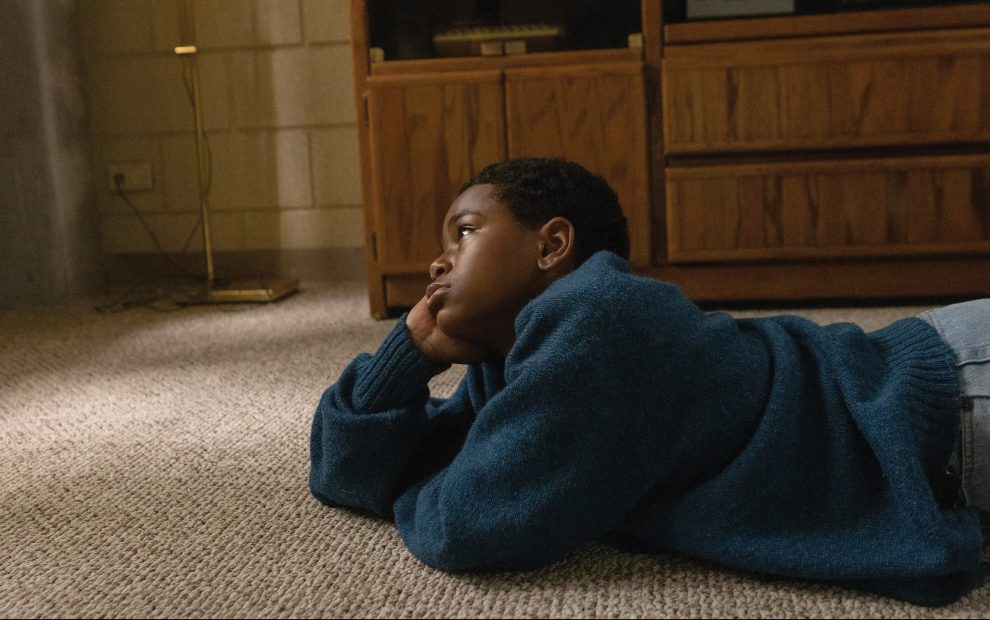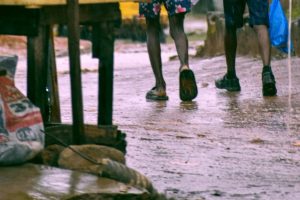In the early 1990s, America was obsessed with violent inner-city crime, especially if it was committed by young Black men. The crack cocaine epidemic was fueling gang wars in every American city. Highly publicized carjackings spread terror among suburbanites. There was media-induced moral panic over gangsta rap tracks such as “F*** tha Police.” In October 1992, at the Cabrini-Green public housing community in Chicago, 7-year-old Dantrell Davis was accidentally killed in a shootout between rival street gangs. Meanwhile, politicians, including our current president, were crafting a legal response that launched the age of mass incarceration.
That’s the world in which Minhal Baig’s feature film, We Grown Now, is set. The story occurs in 1992, in Cabrini-Green, and the violence of that time figures into Baig’s story, but mostly as background. The focus here is on two 10-year-old boys, next-door neighbors and best friends forever, Malik and Eric, their families, and the bonds of love and mutual support that sustain them.
By 1992, Cabrini-Green had become a sort of national shorthand for crime, poverty, and dysfunction. Created in the 1940s with the idea of providing mixed-income housing to returning World War II veterans, the high-rise apartment buildings instead mostly became home to refugees of the Great Migration, which brought millions of Black Southerners to Chicago and other northern cities. In We Grown Now, Malik’s family came north from Tupelo, Mississippi after his grandfather’s business was burned.
In subsequent decades, the projects deteriorated. Lack of funding led to poor maintenance, which led to the community becoming even more exclusively the province of the poorest of the poor. No one who can afford anything else is going to live in a 15-story building in which, as we see in We Grown Now, the elevators often don’t work. In 2000, the city of Chicago started demolishing the Cabrini-Green high-rises.
Cabrini-Green first entered nationwide popular culture in the 1970s as home to the close-knit, loving family featured in the TV sitcom Good Times and as the setting for coming-of-age hijinks in the movie Cooley High. But in 1992, the projects were the setting for Candyman, a slasher film in which the titular super-predator is a supernaturally transformed Black man.
Still, even in those grim days, there were good times in Cabrini-Green. In We Grown Now, the apartments, especially Malik’s, are oases of tenderness and care. Cement block walls are covered with carefully framed family photos, and within those walls, parents move heaven and earth to protect and nurture their children.
Both of the families in We Grown Now are headed by single parents. We’re never told anything about Malik’s father, but the boy grows up with his mother, grandmother, and younger sister in a home presided over by the spirit of his dead grandfather, who brought the family out of Mississippi. Malik has heard the story of the journey north so many times that it replays in his mind every time he hears a train. Meanwhile, Eric is being raised by a single father with the help of his college student daughter. Eric’s father is so devoted to Eric’s dead mother that he still wears his wedding ring long after her passing.
Both boys are fed, loved, and prayed over, and together they make their grim surroundings into an almost idyllic childhood adventure. They haul mattresses from empty apartments down endless staircases to provide a landing pad for their flying leaps across the barren playground. One day they skip out of school and under the public transit turnstiles to wander the city, ending up with a tour of the world-famous Art Institute. At night they stand by open windows, look out over the city, and scream into its vast expanse, “I exist! We exist!”
That’s life in Cabrini-Green Homes from the boys’ point of view, but danger and fear lurk at the edges of the narrative. When the boys skip school, Malik’s mother is wild with terror by the time they return home at sunset. And that’s before Dantrell Davis is killed. The boys are taken to the funeral and are warned over and over, “That could have been you.”
And the danger is not just from the gangsters. After the Dantrell Davis killing, cops are omnipresent at Cabrini-Green, and all residents, children included, must show ID cards to enter the buildings. Then one night Malik’s family is awakened by cops at the door who tear the place apart, supposedly looking for drugs.
Still, from the 10-year-old’s perspective, all of this is overshadowed by the crisis that looms when Malik’s mother is offered a much better job in Peoria, Illinois. The boys come to blows and stop speaking to each other. This leads to a particularly affecting scene in which Malik’s mother fervently prays with and for Eric, seeking healing and forgiveness in the boys’ friendship. As this scene and the one of Dantrell Davis’ funeral make clear, Christian faith is the source and foundation of everything good and lasting in these families’ lives. This is the only movie I recall seeing that has a theological consultant listed deep in the closing credits.
We Grown Now closes with a montage of documentary photographs of life in Cabrini-Green Homes. When the buildings were demolished, residents were given Section 8 housing vouchers and sent out to fend for themselves. They escaped the gangs and the inexorable decay of Cabrini-Green, but they also lost their networks of social support. Cabrini-Green was, in many ways, a den of horrors, but, as the movie shows, it was also a community and a home.
This article also appears in the August 2024 issue of U.S. Catholic (Vol. 89, No. 8, pages 36-37). Click here to subscribe to the magazine.
Image: Sony Pictures/Danielle Scruggs













Add comment